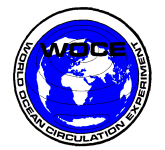



| easterly pseudo-stress (u*w) | (M/s)**2 |
| northerly pseudo-stress (v*w) | (M/s)**2 |
| wind speed (w) | M s**-1 |
| sea surface temperature (sst) | Degrees-C |
| air temperature (at) | Degrees-C |
| sfc humidity (q) | kg kg**-1 |
| easterly wind stress (tx) | N m**-2 |
| northerly wind stress (ty) | N m**-2 |
| sensible heat flux (h) | W m**-2 |
| latent heat flux (e) | W m**-2 |
Grid points over land or non-analyzed data locations are indicated by special value (99999.0).
The data are available in netCDF format(highly recommended) and ASCII. There is one file (ndn6089f.nc, 7.0 mb) for wind stress and turbulent heat fluxes, and the other file (ndn6089m.nc, 10.5 mb) contains the standard meteorological variables. Since netCDF files are fairly well self-describing and transportable across several supported platforms, all support information on reading the data, units, etc are all contained within the files.
Information on netCDF data formatting can be found by contacting the Unidata Program at NCAR/UCAR (see the netcdf.txt file in this directory), e.g. http://www.unidata.ucar.edu/packages/netcdf/
Available in this directory are FORTRAN programs to read the netCDF files (these still require the netCDF libraries!), r6089flx.f and r6089met.f
The ASCII files in this directory can be read with the following code:
integer x(45),y(27)
integer month,year
c
real data(45,27)
read(10,'(20i4)') x
read(10,'(20i4)') y
do 10 i=1,360
read(10,'(i4,2x,i4, 1x, 6e11.4/(7e11.4))')month, year, data
...
...
10 continue
x is an array of longitudes which are the centers of the 2-deg. boxes.
These are in degrees E.
y is an array of latitudes which are the centers of the 2-deg. boxes. These are degrees N, thus negative values indicate Southern Hemisphere.
The data values in array location (1,1) are at 31E, 29S.
month is an integer month indicator (1-12) year is an integer year indicator (1960-1989)
data is a real array(45,27) which contains the analysis field for a single month.
The ASCII data files are: at.asc air temperature, e.asc latent heat flux, h.asc sensible heat flux, q.asc specific humidity, sst.asc sea surface temperature, tx.asc easterly wind stress, ty.asc northerly wind stress, u.asc easterly pseudo-stress, v.asc northerly pseudo-stress, w.asc wind speed.
Any questions regarding these data can be addressed to Dr. David M. Legler (address given below).
In addition, this effort is now supported by NSF (grant OCE-8900077) in support of the Florida State University WOCE Data Assembly Center for Surface Meteorology Data and Special Analysis Center for Surface Fluxes. Contact Dr. David M. Legler for further information.
Dr. David M. Legler Center for Ocean Atmospheric Prediction Studies Florida State University | (850) 644-3797 (Voice) 2035 E. Dirac Dr./Suite-200 Johnson Bldg | 644-4841 (fax) Tallahassee, FL 32306-2840 | Email: legler@coaps.fsu.edu -------------------------------------------- WOCE Sfc Meteorology/Fluxes Center http://www.coaps.fsu.edu/WOCE/ COARE Sfc. Meteorology Data Center http://www.coaps.fsu.edu/COARE/
Jones, C. S., D. M. Legler, and J. J. O'Brien, 1995: Variability of surface fluxes over the Indian ocean; 1960-1989. The Global Atmosphere-Ocean System, 3, 249-272.
Last Modified: Wed, 28 Jan 1998